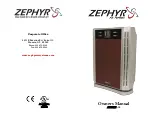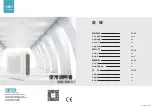
66389-BIM-C-1208
Johnson Controls Unitary Products
47
COOLING TROUBLESHOOTING GUIDE
On calls for cooling, if the compressors are operating but the
supply air blower motor does not energize after a short delay
(the room thermostat fan switch is in the “AUTO” position).
1.
Turn the thermostat fan switch to the ON position. If the
supply air blower motor does not energize, go to Step 3.
2.
If the blower motor runs with the fan switch in the ON
position but will not run after the first compressor has
energized when the fan switch is in the AUTO position,
check the room thermostat for contact between R and G
in the AUTO position during calls for cooling.
3.
If the supply air blower motor does not energize when
the fan switch is set to ON, check that line voltage is
being supplied to the contacts of the M3, contactor, and
that the contactor is pulled in. Check for loose wiring
between the contactor and the supply air blower motor.
4.
If M3 is pulled in and voltage is supplied to M3, lightly
touch the supply air blower motor housing. If it is hot, the
motor may be off on internal protection. Cancel any
thermostat calls and set the fan switch to AUTO. Wait for
the internal overload to reset. Test again when cool.
5.
If M3 is not pulled in, check for 24 volts at the M3 coil. If
24 volts are present at M3 but M3 is not pulled in,
replace the contactor.
6.
Failing the above, if there is line voltage supplied at M3,
M3 is pulled in, and the supply air blower motor still does
not operate, replace the motor.
7.
If 24 volts is not present at M3, check that 24 volts is
present at the UCB supply air blower motor terminal,
“FAN”. If 24 volts is present at the FAN, check for loose
wiring between the UCB and M3.
8.
If 24 volts is not present at the “FAN” terminal, check for
24 volts from the room thermostat. If 24 volts are not
present from the room thermostat, check for the following:
a.
Proper operation of the room thermostat (contact
between R and G with the fan switch in the ON posi-
tion and in the AUTO position during operation
calls).
b.
Proper wiring between the room thermostat and the
UCB.
c.
Loose wiring from the room thermostat to the UCB.
9.
If 24 volts is present at the room thermostat but not at the
UCB, check for proper wiring between the thermostat and
the UCB, i.e. that the thermostat G terminal is connected
to the G terminal of the UCB, and for loose wiring.
10. If the thermostat and UCB are properly wired, replace
the UCB.
On calls for cooling, the supply air blower motor is operating
but compressor #1 is not (the room thermostat fan switch is in
the “AUTO” position).
1.
If installed, check the position of the economizer blades.
If the blades are open, the economizer is providing free
cooling and the compressors will not immediately oper-
ate. If both stages of cooling are requested simultane-
ously and the economizer provides free cooling,
following a short delay compressor #1 will be energized
unless it is locked out. If compressor #1 is locked out,
compressor #2 is energized. Compressor #2 is always
energized in place of compressor #1 when compressor
#1 is requested but locked out.
2.
If no economizer is installed or the economizer is not
opening to provide free cooling and compressor #1 does
not energize on a call for cooling, check for line voltage
at the compressor contactor, M1, and that the contactor
is pulled in. Check for loose wiring between the contac-
tor and the compressor.
3.
If M1 is pulled in and voltage is supplied at M1, lightly
touch the compressor housing. If it is hot, the compres-
sor may be off on inherent protection. Cancel any calls
for cooling and wait for the internal overload to reset.
Test again when cool.
4.
If M1 is not pulled in, check for 24 volts at the M1 coil. If
24 volts are present and M1 is not pulled in, replace the
contactor.
5.
Failing the above, if voltage is supplied at M1, M1 is
pulled in, and the compressor still does not operate,
replace the compressor.
6.
If 24 volts is not present at M1, check for 24 volts at the
UCB terminal, C1. If 24 volts is present, check for loose
wiring between C1 and the compressor contactor.
7.
If 24 volts is not present at the C1 terminal, check for 24
volts from the room thermostat at the UCB Y1 terminal.
If 24 volts is not present from the room thermostat, check
for the following:
a.
24 volts at the thermostat Y1 terminal
b.
Proper wiring between the room thermostat and the
UCB, i.e. Y1 to Y1, Y2 to Y2
c.
Loose wiring from the room thermostat to the UCB.
8.
If 24 volts is present at the UCB Y1 terminal, the compres-
sor may be out due to an open high-pressure switch, low-
pressure switch, or freezestat. Check for 24 volts at the
HPS1, LPS1, and FS1 terminals of the UCB. If a switch
has opened, there should be a voltage potential between
the UCB terminals, e.g. if LPS1 has opened, there will be
a 24-volt potential between the LPS1 terminals.
9.
If 24 volts is present at the UCB Y1 terminal and none of
the protection switches have opened, the UCB may have
locked out the compressor for repeat trips. The UCB
should be flashing an alarm code. If not, press and
release the ALARMS button on the UCB. The UCB will
flash the last five alarms on the LED. If the compressor is
locked out, cancel any call for cooling. This will reset any
compressor lock outs.






































